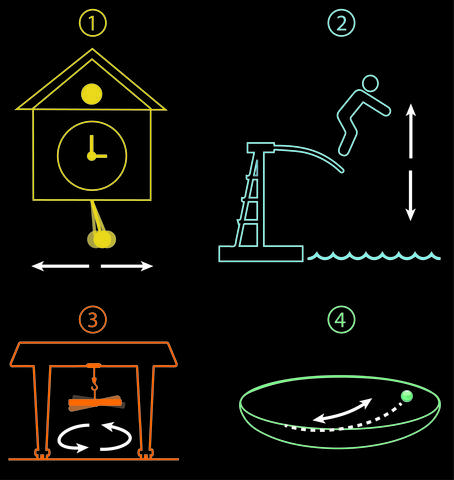A New Harmony: NIST Researchers Develop a Universal Method for Calculating the Resonances of Oscillators
Technique may improve measurement accuracy of myriad commercial and scientific sensors.

Examples of harmonic motion in which objects oscillate at a resonance frequency. NIST researchers and their colleagues have developed a universal estimator to more accurately calculate the lowest possible uncertainty in measuring resonance frequencies, which play a key role in devices ranging from sensors to components in wireless communication.
The natural, or resonance, frequency at which a simple harmonic oscillator vibrates reveals with exquisite sensitivity the essential properties of the physical system to which it’s coupled. For instance, the resonance frequency of a guitar string indicates its length, mass, and tension. The resonance frequencies of miniature mechanical, acoustical, or optical harmonic devices can reveal such properties as the atomic-scale mass, motion, force, and acceleration of a system.
Resonance frequency measurements are integral to a host of scientific and commercial endeavors, from atomic force microscopy to high-precision, wireless communication, to the detection of single molecules. Resonators have even measured gravitational waves, disturbances in the geometry of space-time caused by the acceleration of massive objects.
Researchers are continually seeking ways to ensure they are measuring these frequencies with the highest accuracy possible. Yet until now, scientists had not developed a universal, fundamental way of understanding and estimating the uncertainties in measuring the resonance frequencies of harmonic oscillators.
Scientists at the National Institute of Standards and Technology (NIST) and their colleagues have calculated just how precisely scientists can measure the resonance frequencies of any harmonic oscillator – no matter what its physical properties. The calculation incorporates thermodynamic, quantum, and instrumental uncertainties, as well as whether a harmonic oscillation is driven by an external force or freely fluctuating, among a host of other factors.
NIST scientist Vladimir Aksyuk and his colleagues also derived a universal estimator for calculating resonance frequencies with the lowest possible uncertainty based solely on the motion of the oscillator. Then they put their theoretical calculations to the test. The NIST researchers and collaborators from the University of Maryland in College Park and the Worcester Polytechnic Institute in Massachusetts conducted several experiments with a mechanical resonator small enough to fit on a microchip.
The scientists reported online in the Sept. 15, 2021 Communications Physics that they could indeed estimate resonance frequencies of the nanoscale device with an error precisely as low as the theoretical analysis predicted. The estimator provided the lowest possible error for measurements lasting as long as one second or as short as 30 millionths of a second.
Prior to the new work, physicists analyzed resonance measurements on a case-by-case basis; for instance, whether a resonance is driven by an outside force or affected by quantum uncertainties. In addition, the study identifies factors, such as the random motion of atoms in an oscillator due to their temperature, which are often considered sources of noise but in fact provide vital information about the resonance. Just as a guitar string that is randomly plucked will vibrate at its natural or resonant frequency, so will an oscillator subject to the random motion of atoms.
When these factors are not taken into account, researchers may radically underestimate the precision with which resonant frequencies can be estimated, Aksyuk said.
“In a field with more than a hundred years of history, the authors have determined the limits of frequency estimation for a broadly applicable case, developed an estimation method that achieves the limit, and validated the approach in a physical system,” said NIST scientist Thomas LeBrun, who was not a coauthor of the new study. “The new work can advance a large field of research and applications rather than address a specific urgent requirement.”
Aksyuk and his colleagues extended their theoretical understanding of the measurement precision to include harmonic oscillators for which quantum uncertainties dominate. For such oscillators, the uncertainty principle, which holds that the position and momentum of a particle cannot be measured exactly at the same time, must be taken into account. Because of the uncertainty principle, a precise measurement of the position of the oscillator induces a sort of a kick, known as the quantum back action, which makes the oscillator’s momentum less certain.
The researchers were able to include the back action in their calculations of the lowest possible uncertainty in measuring resonance frequencies. In fact, they described how to use these kicks to measure resonance frequencies by continuously observing the motion of an oscillator isolated from all other forces.
It might seem that an oscillator driven only by the backaction wouldn’t vibrate, but these quantum kicks do indeed excite the resonance frequency of the system.
The theory provides a better understanding of how accurately resonance frequencies can be measured in systems that have not been previously analyzed in detail. These include harmonic oscillators whose resonance frequency varies rapidly. The estimator gives researchers a practical way to calculate the resonance frequency from the measured motion and to obtain the best precision possible.
Although the team only examined nanomechanical resonators, Aksyuk said the frequency measurement limits his team calculated, along with the estimator, apply to optical, atomic, and other resonators whose motion is continuously monitored.
Paper: Mingkang Wang, Rui Zhang, Robert Ilic, Yuxiang Liu, and Vladimir A. Aksyuk. Fundamental limits and optimal estimation of the resonance frequency of a linear harmonic oscillator. Communications Physics. Sept. 15, 2021 DOI: 10.1038/s42005-021-00700-6

